Bullseye from 1,000 yards: Shooting the $17,000 Linux-powered rifle
ARM CPUs, lasers, and Wi-Fi make firing this weapon an experience like no other.
1000 yards is a long, long way away. http://arstechnica.com/gadgets/2013/03/bullseye-from-1000-yards-shooting-the-17000-linux-powered-rifle/
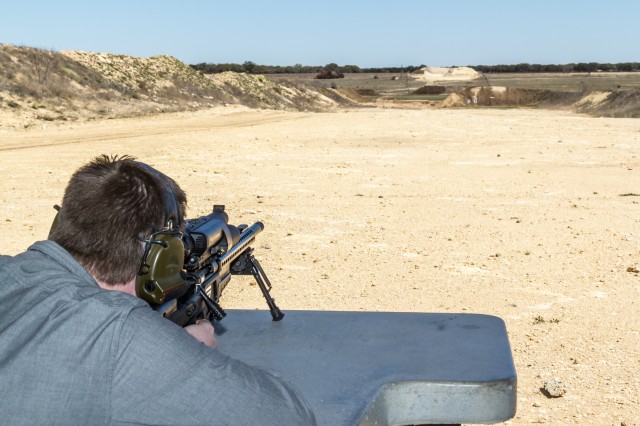 My photographer, Steve, squints through a computerized scope
squatting atop a big hunting rifle. We're outdoors at a range just north
of Austin, Texas, and the wind is blowing like crazy—enough so that
we're having to dial in more and more wind adjustment on the rifle's
computer. The spotter and I monitor Steve's sight through an iPad linked
to the rifle via Wi-Fi, and we can see exactly what he's
seeing through the scope. Steve lines up on his target downrange—a
gently swinging metal plate with a fluorescent orange circle painted at
its center—and depresses a button to illuminate it with the rifle's
laser.
My photographer, Steve, squints through a computerized scope
squatting atop a big hunting rifle. We're outdoors at a range just north
of Austin, Texas, and the wind is blowing like crazy—enough so that
we're having to dial in more and more wind adjustment on the rifle's
computer. The spotter and I monitor Steve's sight through an iPad linked
to the rifle via Wi-Fi, and we can see exactly what he's
seeing through the scope. Steve lines up on his target downrange—a
gently swinging metal plate with a fluorescent orange circle painted at
its center—and depresses a button to illuminate it with the rifle's
laser."Good tag?" he asks, softly.
"Good tag," replies the spotter, watching on the iPad. He leaves the device in my hands and looks through a conventional high-powered spotting scope at the target Steve has selected. The wind stops momentarily. "Send it," he calls out.
Steve pulls the trigger, but nothing immediately happens. On the iPad's screen, his reticle shifts from blue to red and drifts toward the marked target. Even though I'm expecting it, the rifle's report is startling when it fires.
A second later, the spotter calls out, "That's a hit!"
Steve has just delivered a .338 Lapua Magnum round directly onto a target about the size of a big dinner plate at a range of 1,008 yards—that's ten football fields, or a tick over 0.91 kilometers. It's his very first try. He has never fired a rifle before today.
A
shot with the XS1 at 1,008 yards (922 meters). The shot-drop
reorientation at this range is clearly visible. It also takes several
seconds after the trigger is pulled (reticle turns red) for the rifle's
computer to judge the alignment as favorable enough to fire. The spotter
can be heard noting that the round impacts "center mass," or directly
in the middle of the target. (The time & date displayed at the
bottom of the scope are incorrect.)
Through the shooting glass
Of course, Steve isn't some kind of super mutant marksman—he had a bit of help. We were plinking targets with $17,000+ Linux-powered hunting rifles, made by a small Austin company called TrackingPoint. Earlier this year, Ars reported on TrackingPoint's "Precision Guided Firearm" at CES, where the 59-employee company was giving the press a sneak-peak at their product before its official introduction at the Shot Show convention a week later.The Precision Guided Firearm is a "whole widget" type of thing—it's not just a fancy scope on top of a fancy gun, but rather a tightly integrated system coupling a rifle, an ARM-powered scope running a modified version of Angström Linux (with some custom BitBake recipes and kernel modules to support the rifle's proprietary hardware), and a linked trigger mechanism whose weighting is controlled by the scope.
TrackingPoint actually makes three different Precision Guided Firearms, two of which fire .300 Winchester Magnum rounds and one of which fires a larger .338 Lapua Magnum cartridge. The weapons themselves are crafted by Surgeon Rifles, and TrackingPoint adds the scope and trigger mechanism to the rifle and then sells it as a package. Since launch, TrackingPoint's sales have been very brisk: the company has nearly sold out of their entire allotment of PGFs for all of 2013.
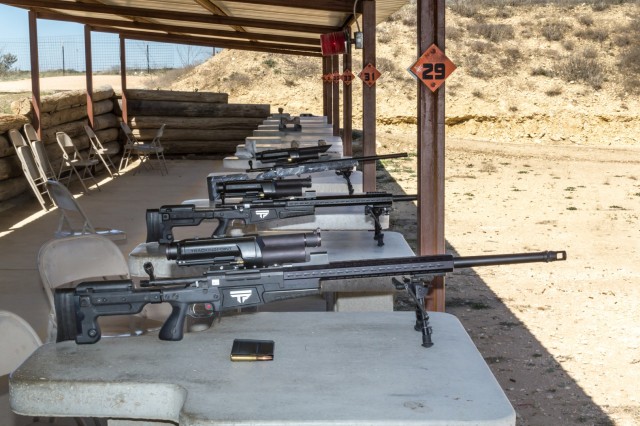
Enlarge /
All three PGFs. Foreground is the .338 LM XS1, middle is the .300
WinMag XS2, and rear is the .300 WinMag XS3. .338LM magazine and
cartridges are also shown in foreground.
What's it like to shoot?
I've fired a small number of bolt-action rifles before, but nothing as big as the .338 LM-chambered XS1, on which we spent most of our range time. The oddest thing about firing TrackingPoint's rifles, the thing wildly different from a standard hunting rifle, is the trigger mechanism. The rifle's "Tag-Track-Xact" technology means that there is a delay between when you pull the trigger and when the rifle fires—sometimes several seconds of delay, depending on how steady your aim is. This disconnect between trigger pull and firing can be weirdly disconcerting.All of the interaction with the rifle's computer is done through the computerized tracking scope, which displays an image of the world in front of the rifle, overlaid with data. It's reminiscent of a fighter jet heads-up display.
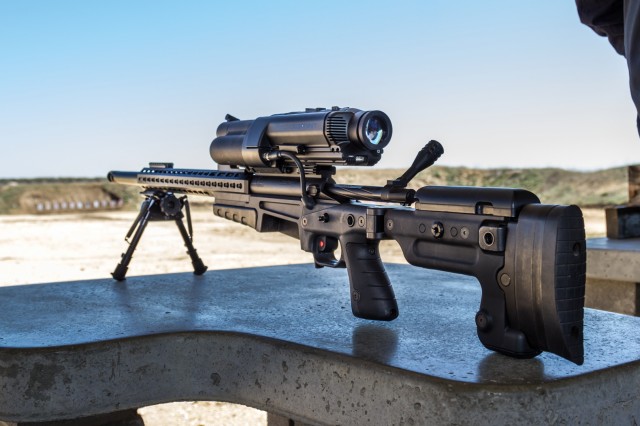
Enlarge /
Oblique view of the mid-range XS2 PGF. Visible is the data connection
between the computerized tracking scope and the guided trigger
mechanism. Also visible is the red "track" button, which can be operated
ambidextrously.

Enlarge / A visual explanation of TrackingPoint's "Tag-Track-Xact" system.
Once the target is tagged, the laser ceases illuminating and the embedded system's image recognition routines take over. If the target is a game animal, the scope will track the animal's movement in the field of view, and the red pip will remain stuck to the point on the target where it was originally tagged. This level of precision obviously helps out at the range, but it also enables a hunter to more ethically harvest animals by precisely targeting specific areas—the tagging mechanism greatly simplifies the process of killing the game animal with a single shot, rather than wounding it and inflicting unnecessary suffering.
After the target has been tagged, the scope's reticle changes to a large blue "X," and the weapon can be fired. To actually send a round downrange to the target, you depress the weapon's trigger. This doesn't cause the weapon to immediately fire, though—the reticle turns red, and while keeping the trigger held down, you must align the reticle with the tagged pip. Once the pip and the reticle coincide, the weapon fires.
Scoring
a hit at 750 yards (685 meters) with the .300 WinMag XS2 rifle. The
shift in view at the beginning of the video is the scope's computer
compensating for the anticipated bullet drop by realigning the sight
picture so that the tagged spot on the target occupies the middle of the
view.
Yeah, but how does it feel?
The hefty Surgeon rifle feels like a quality firearm should—it's solid and its bolt operates with a reassuring ka-chunk-ka-chunk. Like most firearms, it works best when operated authoritatively—you firmly seat the magazine and firmly close the bolt to put the weapon in battery. We spent less time on the .300 Winchester Magnum-chambered XS2 and XS3 rifles, but the operational feelings were similar. The XS2 and XS1 are very close in appearance, with the main visual difference being the barrel length. The XS3 is smaller, with a more traditional rifle stock grip instead of a pistol-style grip. All of the rifles come with forward bipods attached so that they can be fired from a supported position without requiring sandbags or any other kind of brace.Just about everyone who fires a pistol or rifle goes through an adjustment period where they anticipate and overcompensate for the recoil the weapon produces when fired. The overcompensation is an almost unconscious adaptation that the body makes. Overcoming it is part of learning to shoot. Firearms are loud, and when they are fired they jump back in your grip. So, less-experienced shooters cope with the recoil by bringing the weapon's barrel downward against the anticipated force—often before they've even fired the weapon.
The only way to learn to cope effectively with a weapon's recoil is to practice, and the adjustment period lasts a different length of time for every person. There are things you can do to help (I've had instructors in the past recommended balancing a penny on your weapon's front sight and dry-firing until the penny doesn't move as a way to teach a steady trigger pull), but one way or another it's something everyone has to deal with.
TrackingPoint's rifles, though, remove overcompensation from the equation by totally segregating the act of pulling the trigger from the weapon's firing. Also no longer necessary is holding your breath to avoid disturbing your sight picture or timing your shot to your heartbeat or other long-range tricks—the rifle's computer picks the most optimal time to fire. You pull and hold your trigger, and then carefully align the reticle with the floating red pip.
There is a side effect, though. Rather than overcompensating for trigger pull, I found myself shying back from the rifle after I'd pulled the trigger. One issue with the preproduction PGFs we were shooting was that there was no eyepiece on the scope, and so you needed to manually judge how far back to position your eye so that the scope didn't bash you in the face when the rifle was fired (something that TrackingPoint repeatedly told us will be remedied on the production PGFs). But more than just not wanting a black eye, the removal of the instant feedback between trigger pull and firing gets rid of one type of anticipatory cringing and introduces another. At long-range, you need to hold the reticle over the pip for a moment before the computer fires, because the tiny perturbations in the rifle's aim introduced by your muscles' attempts at not moving translate into very large deviations at the end of a thousand yards. That means that there's sometimes a multi-second period where you're squeezing the trigger and braced for the rifle's kick.
Every time the PGF fired, it was a surprise. Sometimes, my alignment would be great and it would send a round almost before I was ready (including on one instance where I was going to provide a countdown for my cameraman and managed to fire the rifle before I even got to "one"). Other times, especially at range, it would take two, three, four seconds of apparent dead-on coincidence between pip and reticle before the rifle would fire.
The tech
A lot of the delay is because what the user sees in the sight picture isn't always exactly what the rifle's computer is looking at. The rifle gets its view of the world through the computerized tracking scope, which looks out through a 35x fixed-magnification optic focused onto a digital imaging sensor with a vertical resolution of about 3600 pixels. Behind the optic assembly is an entire ARM-powered embedded system that knows everything there is to know about the characteristics of the rifle and its ammunition. The tracking scope also contains instrumentation to make it aware of ambient conditions, including temperature and humidity and atmospheric pressure, the incline and cant of the weapon, and its compass heading. The only thing you need to manually enter is the wind speed and direction, using a control on the top of the scope.
Enlarge / A diagram of the computerized tracking scope, from TrackingPoint's marketing materials.
Not quite a robo-gun
Even though you tag and track targets and the rifle picks the exact moment to release the round, TrackingPoint's Bret Boyd is quick to point out that the PGF systems don't fire "by themselves." The weapon's user is in full control of when the rifle fires and can safe the weapon at any time by releasing the trigger. An autonomously firing weapon simply isn't something that the US Bureau of Alcohol, Tobacco, and Firearms would allow to be sold.Rather than being connected mechanically to the firing pin, the "guided trigger assembly" includes a solenoid which actuates the firing mechanism. The solenoid releases only when the trigger is pulled and when the tagging pip coincides with the scope's reticle. According to TrackingPoint, the rifle's computer "dynamically inflates and deflates" the trigger weighting required to trip the solenoid and cause the weapon to fire.
This sounds a little odd and might give the impression that the trigger actually moves under your finger as its weighting is varied. But this is incorrect: the trigger does not move on its own. You pull it and hold it to signal to the rifle that you want it to fire. Prior to lining up the reticle and tagged pip, the trigger's effective pull weight is set to higher than the force you're exerting on it. When the shot is lined up and the rifle's computer calculates it's the optimal moment for the weapon to be fired, the trigger's effective weight drops below the amount of force you're exerting and the weapon fires. TrackingPoint describes it as a "blocking" function, rather than a "self-firing" function. It's a somewhat thin line to walk, but it's compliant with the law. In practice, the differentiation is moot.

Enlarge / Zooming and entering wind data is done through depressing rocker switches on top of the scope.
Razors and razor blades
The PGF is able to function at range because the system is preprogrammed with the ballistic characteristics of not just the three types of rifles, but also of the ammunition. TrackingPoint has partnered with ammunition manufacturer Barnes Bullets to turn out ammunition with very specific characteristics, effectively selling both the razor and the razor blades. Our original coverage of TrackingPoint from CES drew lots of questions about reloading or hand loading—that is, assembling one's own ammunition from casings and powder and bullets—so I brought this up with Bret Boyd while we were at the range."Gun people are very passionate, and if you're into reloading and hand loading you're in the one percentile." We talked between shots, wearing identical Peltor electronic ear protectors. "The problem with hand loading is that you just have inconsistent results. Some people do it very good, and some don't. What I really want to avoid is the situation where someone says, 'Look, your gun doesn't work. I'm missing, and it's your fault.' And the real issue is, well, you're missing because you screwed up the ammunition—you have it loaded too hot and it's firing too high. But you're never going to believe me!" He laughed. "I'm really not trying to make a ton of money on ammo, but I want to control the outcome and I want people to have a good experience."
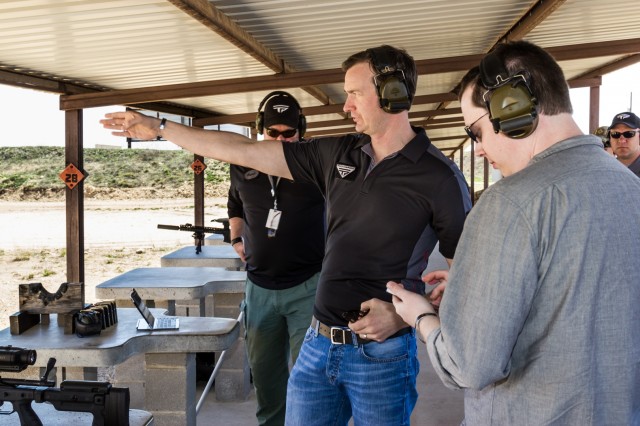
Enlarge / TrackingPoint VP Bret Boyd during our range familiarization talk.
A “paramilitary” rifle?
The elephant in the room, though, is that these rifles could have applications beyond sport hunting—what could be used to lock onto and take down a running deer at 1000 yards could conceivably be used to lock onto and shoot a person, too. Venturebeat editor-in-chief Matt Marshall went so far as to call TrackingPoint's products "disgusting" and "truly repulsive," saying that the rifles "are paramilitary weapons." He invoked the image of a madman like John Allen Muhammad using one to pick off innocent people from "a mile away."That's the subtext behind a lot of the negative reaction to TrackingPoint's PGF technology: its potential use against people, either in the hands of a soldier, a policeman, or the proverbial crazy person. I'd argue that it's far more likely a mass shooting event would take place with conventional firearms than with a PGF; a bolt-action hunting rifle isn't exactly the quickest method of getting a lot of lead on a lot of different targets. The very nature of the PGF's "Tag-Track-Xact" scope encourages methodical target selection at range, and hauling even a hypothetical smaller PGF into a crowded place and letting loose would be enormously difficult. It's not a close-quarters weapon by any stretch of the imagination.
Fear-mongering aside, two things are quite obvious about the three PGF rifles that TrackingPoint is launching with. First, they're not particularly good "paramilitary weapons," as paramilitary weapons go. Second, though, is that they're only the first round of PGFs.
The lightest PGF, the XS3, has a 22" barrel and is chambered in .300 Winchester Magnum. Including the weight of the scope and bipod, it weighs 15lbs (about 7kg). The larger XS1, the only one of the three with which we were able to consistently hit targets at 1000 yards, is about 4lbs heavier. The weapons have a heavy and relatively fragile computer on top of them, filled with electronics and glass. They're not rugged enough to survive anything like a battlefield, urban or otherwise. You don't want to drop them out of a tree or slam them into a wall or get them wet.
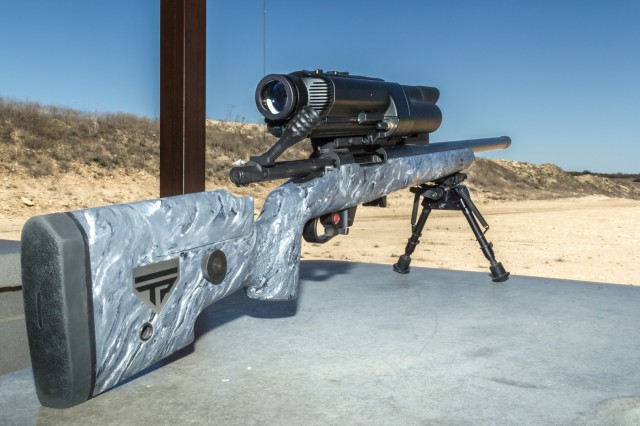
Enlarge /
Oblique view of the XS3, the lightest and most portable of the three
PGFs. "Portable" is relative, though, as the whole rifle still weighs
more than 15lbs (about 7kg).
"This is just a lot of gun," explained Boyd. "The average [law enforcement] sniper engagement is 75 yards, like from the house across the street....You look at cops and they all have short-barreled Remington 700s that weigh eight pounds."
That's not to say that TrackingPoint hasn't been demoing their products to law enforcement and some government agencies. "We've shot with the Austin SWAT guys," Boyd noted. "They all think it's great. We've flown out to DC and I've done demos with the Secret Service, their counter-sniper guys, and the FBI, their Hostage Rescue guys...and those are organizations we expect to be customers at some point."
Certainly those are "paramilitary" applications, but sharpshooters like those on the FBI's Hostage Rescue Team are already world-class marksmen. "The thing that they like the most about it is not really the marksmanship and ballistics—they're already very good at that—but it's more the recording and the networking," elaborated Boyd. The PGF's integrated recording capabilities would function like the dashboard cameras in a police cruiser, documenting exactly what the shooter sees, exactly where his or her round was aimed, and the exact conditions under which a round was fired.
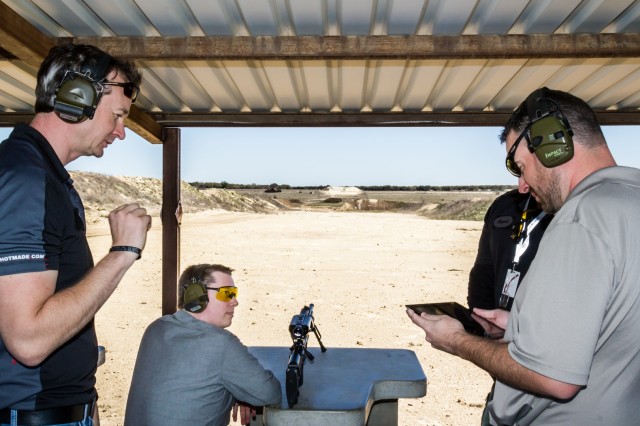
Enlarge / The Wi-Fi connection and recording lets users analyze each shot and discuss it after.
"From a business strategy perspective, we went very high-end long guns year one—building and explaining to people what a PGF is," he continued. "We intend to expand into other calibers and other action types next year. And then from there, standalone optics and other types of devices are a total possibility....My guess is that if we were to do something with pistols or a short-barrel rifle that would come a little further down."
With different requirements and capabilities, though, comes potentially smaller weapons. The size and weight of the three PGFs on sale today are driven by the requirements: they're hunting rifles that need to be able to hit a target up to a thousand yards out. Easing those requirements means that the computerized scope can become smaller, too.
"Keep in mind, there's a big laser in there and there's a lot of glass," said Boyd. "If you don't need to go as far, the laser doesn't need to be as big....And with that, power requirements shrink. The battery compartment is a lot of that center cabinet. We can make the form factor smaller if we didn't want to shoot as far."
The computerized system itself, the tracking scope and trigger, could end up being quite modular: "Theoretically, we can align this with any system we want," Boyd continued. If a future customer were to approach TrackingPoint and ask to have an existing stock of firearms converted to precision guided weapons, explained Boyd, "...it's just an issue of shooting a lot of rounds, measuring how they fly in different environments and different angles and so on and so forth to profile how the gun shoots."
Social shooting
But shooting TrackingPoint's rifles isn't just about shooting the rifles. Hidden inside the tracking scope's guts is a Wi-Fi antenna, and the weapon can form an ad-hoc Wi-Fi network and link up with a specially crafted iOS app running on an iPad (TrackingPoint includes an iPad with the app pre-loaded when you buy a PGF—the marginal cost of adding an iPad into the mix on a $17k purchase is negligible).The iPad app displays video streamed from the scope over Wi-Fi. Everything that the weapon's user sees in the optic is shown on the iPad's screen—all the ambient condition data, the reticle, the tagged point, everything. It's a powerful tool to assist a new hunter with how and where to line up a shot. On the target range, our spotter flipped back and forth between the iPad and a traditional spotting scope as we fired, using the iPad to confirm where our tags were placed on the targets and using the spotting scope to check for hits on the targets too far away to hear the impact.

Enlarge / While I fired the weapon, the rest of the group could see exactly what I was seeing through my scope via the Wi-Fi-linked iPad.
The idea of duplicating the sight picture on a separate screen is only the start. The streaming video lets a spotter see exactly what the rifle's user sees, but it's passive—the iPad displays a live picture of the PGF's scope, but nothing more. TrackingPoint is kicking around the idea of eventually releasing an actual spotting scope equipped with the "Tag-Track-Xact" technology. It would be capable of linking up via Wi-Fi to a PGF and could be used to call shots, letting a spotter actually designate targets that would show up on the PGF's display.
Something that's not particularly likely, at least for now, is integration with an augmented reality system like Google Glass. The idea seems like it could be a good fit—getting a sight picture beamed into your eye without having to peer into a scope—but TrackingPoint doesn't believe that Google would be interested in integrating with them and they haven't pursued any formal relationship. "Google actually has some reasonably prohibitive policies around firearms," explained Boyd. "I don't really think they're going to be a good partner for us."
The next best thing to being there
You don't necessarily have to buy an expensive rifle or join a hunting club to get some idea of how the PGF system works, though: TrackingPoint has released a free iOS app called Precision Hunter Lite that simulates the functionality of the XS1 rifle (although aside from the maximum range, the three rifles all work the same way).Precision Hunter Lite works with both the iPhone and iPad, but after trying it on both, I wouldn't particularly want to use it on a phone—the iPad's larger screen makes it a lot easier to see things. There's not a whole lot of "game" in the free game, but it provides a good simulation of the "Tag-Track-Xact" system.
You can choose to play a brief tutorial or jump right into a three-animal hunt. There are a number of game animals to pick from, all the way up to bears and elk. The larger animals are perhaps a bit easier to hit (being larger), but seem to require more precision to kill with a single shot.
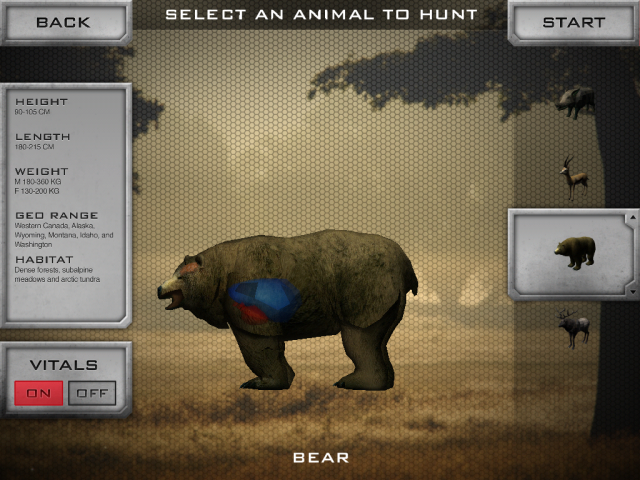
Enlarge / Going after the big game.
Present in the game's field of view but not on the actual rifle are a tag button, a trigger button, controls to zoom the view in and out, and a pause button to summon the menu. It's a relatively simple matter to look around, locate an animal, and tag it with your left thumb. When holding down the tag button, the view stabilizes momentarily just like the real rifle, and after tagging a target the view disconcertingly reorients itself, just like on the real rifle. To fire, you hold down the trigger with your right thumb and bring the reticle over the pip.

Enlarge /
Tagged a bear at 334 yards. Aside from the polygons, this is pretty
much exactly what using a Precision Guided Firearm looks like.
To get the iOS app as accurate to the appearance and function of the real weapons as possible, TrackingPoint partnered with Austin-based development studio Chaotic Moon. The app is built in Unity, and although it doesn't share any actual code with the embedded ARM computer in a production PGF, it is using the same mathematics to calculate how the simulated weapons shoot.
The game is a fun little thing that gives you a good idea of what firing the real weapon looks like but, again, there's not much game there yet. TrackingPoint has plans to eventually release a "pro" version, with a career mode and achievements and more varied environments, but that's some time out.
The iOS app, while quite clearly a game, does look pretty much exactly like the production weapon's display, except that the world seen behind the floating letters isn't polygonal but very real. Adding a social media aspect on to hunting—an activity which involves taking life—is something that a lot of folks find troubling. It's one thing to get an achievement for scoring a thousand head-shots in Call of Duty or whatever, but not everyone would be thrilled about potentially seeing a PGF-generated "Jonny bagged his first kill!" notification pop up in their Facebook timeline.
Who's buying?
The average sport shooter likely doesn't have about $20k to drop on a single rifle, but even with the high barrier to entry, TrackingPoint's initial supply of rifles is almost totally allocated. No small number of sales have been to hunting clubs and other large organizations, too. Interest in acquiring one or two rifles for rental and club use has been high, and Boyd explained that the rifles could be employed by clubs to aid new hunters in learning how to properly and humanely hunt, and to allow older hunters to go out and bag an animal that they might not have the stamina to otherwise stalk and take down.TrackingPoint is exploring ways to make a PGF purchase a "white glove" type of experience. Though this isn't yet a possibility, TrackingPoint's PGFs might eventually be available as part of an entire "destination" package, where a customer purchases a PGF coupled with an African safari or something similar. TrackingPoint might also offer some training range time with each rifle's purchase, much like how BMW owners can choose to purchase a new BMW and take delivery of it at the company's South Carolina performance driving school along with a day of driving lessons.
But for now private sales make up the majority of the orders. TrackingPoint isn't releasing detailed numbers yet, other than to say that they've taken preorders for "hundreds" of PGFs. They expect to begin delivering the weapons to customers in May of this year.
Shots, made

Enlarge /
A view downrange, showing 250 yard, 500 yard, 750 yard, and 1000 yard
target emplacements. At 128mm equivalent zoom, our camera's lens
foreshortens the distance, making the targets appear much, much closer
than they do to the naked eye.
"In 10 years, precision guided firearms is just going to be another class of weapons that a ton of people are going to make," he predicted as we were packing up. We'd spent several hours shooting in the cool, dry Austin air, racking up hit after hit on targets so far away that they couldn't be seen unaided, watching each other's scopes through iPads. It all felt a little unreal.
"I can't believe you've never shot a rifle before," Boyd commented to Steve, shaking his head.
"Well, pistols, but not rifles," replied my photographer.
"Not too many thousand-yard pistol shots, though?" asked Boyd.
"Nope!" Steve agreed. We started walking back toward the car and home, all new members of the thousand yard club.



No comments:
Post a Comment